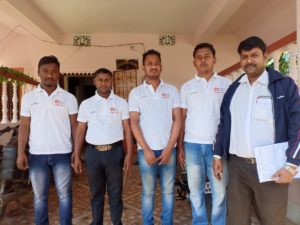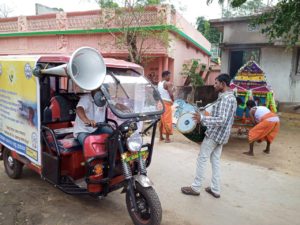 The vision of Smart Power India is to positively impact millions of lives by accelerating electricity access in rural communities. In this exchange with T&D India, we have Jaideep Mukherji, CEO, Smart Power India, telling us more on mini-grids and the deep positive impact that they can have on rural India. Smart Power India’s ambition to improve electricity access of 25 million Indians over the next three years.
The vision of Smart Power India is to positively impact millions of lives by accelerating electricity access in rural communities. In this exchange with T&D India, we have Jaideep Mukherji, CEO, Smart Power India, telling us more on mini-grids and the deep positive impact that they can have on rural India. Smart Power India’s ambition to improve electricity access of 25 million Indians over the next three years.
Let us start by getting a basic idea of what a mini-grid is.
Mini-grids help provide last-mile electricity in areas where traditional grids have not been able to reach, or where power supply is unreliable and unstable. They help serve a variety of customers including private households, small businesses, and agricultural loads.
A mini-grid is a set of small-scale electricity generators and energy storage systems interconnected to a distribution network with a capacity of more than 10kW. It supplies electricity to a small, localized group of customers and operates independently from the national transmission grid. Mini-grids can run on diesel, renewable energy, or as renewable-diesel hybrids.
While mini-grids have been used as an off-grid solution to provide energy, they can also be connected to the government grid and feed in their surplus renewables-based electricity. Integrated mini-grids are a cost-effective and timely solution for meeting the energy demands of India.
“We aim to impact millions of lives by accelerating electricity access among the rural community.”
We understand that Smart Power India is actively engaged in providing electricity access to rural India through mini-grids. Tell us more.

SPI envisions to provide access to reliable electricity to all. We aim to impact millions of lives by accelerating electricity access among the rural community. We believe that meaningful electricity access goes beyond provision of electric connection, encompassing the predictability and quality of power, as well as responsive consumer service.
Mini-grids, operated by private energy service companies, stand out as one of the few distributed solutions that provide reliable electricity for both domestic and productive use. We are working with a wide range of stakeholders to develop the mini-grid sector in India – from technical, financial, business, and policy perspectives. The electricity from these grids is transforming the lives of more than 3 lakh people, by providing electricity for lighting and fans, electric water pumps, household appliances, and motors for productive uses such as water filtration units, micro-enterprises and schools etc.
Today, more than 300 renewable energy mini-grids cumulating to 9.2 mw of capacity, supported by Smart Power India, are set-up across Bihar, Uttar Pradesh and Jharkhand, the largest such cluster in India.
“In India, government grid infrastructure now has a very good reach; but mini-grids still have an important complementary role to play.”
In rural India, why are mini-grids a better option than using the conventional grid?
Mini-grids can supply electricity to isolated areas, which are not supplied to the grid due to economic and geographic constraints. In India, government grid infrastructure now has a very good reach; but mini-grids still have an important complementary role to play in last-mile electricity delivery, notably in scenarios where grid supply is weak or connection rates are low.
While grid electricity has reached almost every household, mini-grids work for smaller productive loads like enterprises where grid is yet to reach. This is where we have plugged in our mini-grids.
Mini-grids can help provide higher reliability, consistency and quality of supply. As private players, they also adopt a customer-centric business strategy. These are two of the main reasons that our customers value the service we and our partners provide, and are willing to pay tariffs which are higher than for subsidized government electricity.
SPI believes that traditional grids can benefit from mini-grids’ ability to service rural customers: this is a win-win-win situation for all the three stakeholders (customers, mini-grid operators, and discoms). Moreover, integrating mini-grids with the government grid will increase the affordability of the electricity, and help achieve the SDG7 target of “Universal access to affordable, reliable and modern energy services”.
“Smart Power India works to spread knowledge and awareness about technical performance monitoring and maintenance techniques.”
What are the typical challenges that one may encounter whilst setting up rural mini-grids?

It is critical to set up the mini-grids in a catchment area which provides electricity to both households as well as productive units. Selection of the site requires careful on-ground research and analysis.
Technological challenges often crop up while setting up mini-grids. The operating conditions in rural areas, in terms of temperatures, loads, real-time monitoring, etc., tend to be sub-optimal; electrical components like batteries and inverters needs to be of high quality and properly maintained, in order to safeguard the technical health and performance of the mini-grid. SPI works to spread knowledge and awareness about technical performance monitoring and maintenance techniques.
Low confidence of customers with electricity supply is a major challenge that we need to address before setting up mini-grids. Engagement and trust building with local community is critical for effective & safe operations of the mini-grid. We use community-based strategies for metering and billing, and are constantly exploring ways we can support local entrepreneurs to develop micro-enterprises. For example, we have helped women self-help groups to upgrade their electric mustard oil expellers, source raw mustard seeds from local farmers, and connect with downstream buyers. This reaffirms the importance of reliable electricity, and motivates the community to support mini-grid operators.
Mini-grids also require high operational involvement in comparison to traditional grids. To operate mini-grids efficiently, it is essential for the company to interact will all households to build trust, and also to provide maintenance services and collect revenues. This makes it unfeasible for most large established players to set up mini-grids.
“Battery storage systems have a significant role to play in the cost-effectiveness of renewable mini-grid solutions.”
In the context of rural mini-grids in India, how big a challenge is energy storage?

Battery storage systems have a significant role to play in the cost-effectiveness of renewable mini-grid solutions. Solar mini-grids are heavily reliant on batteries for evening and night-time supply – the hours when residential demand peaks. There is strong interest among developers in exploring and adopting advanced battery technologies with superior performance and lower life-time cost.
Currently the most widely-used batteries are of the sealed lead-acid type. These are readily available, proven, and have a low up-front cost; but they suffer greatly when subjected to the harsh operating conditions mentioned previously. Over the course of a mini-grid’s lifetime, the entire battery bank will wear out and need replacing maybe five times. We encourage mini-grid operators to take conscientious steps to take care of batteries, and this can significantly improve their life and performance, And we continue to investigate new and alternative solutions in this space.
Smart Power India is supporting Tata Power Renewable Microgrid Ltd in its plan of setting up 200 rural mini-grids, as part of the project’s first phase.
We understand that Smart Power India is associated with the rural mini-grids project of Tata Power and Rockfeller Foundation. What will be your role in the project? What is the current status of this project, and how do you see the way forward?
Over the past three years SPI has supported the development of 300+ mini-grids, developing a deep understanding of best practices in building, managing and operating mini-grids for productive use and socio-economic development of rural communities.
SPI has formed a Project Management Unit (PMU) to support Tata Power Renewable Microgrid Ltd (TPRMG) as it operationalize its Phase 1 (200 plants) mini-grid business plan. Key support areas include site selection, demand creation for productive use, technical and customer engagement training, technology selection and data management & analytics. In the short-term, experts from SPI will work closely with TPRMG management and ground team to build their internal capacity on various aspects of the mini-grid ground operations. In the long-term, SPI experts will focus on creating consumer demand for mini-grid electricity at TPRMG mini-grid sites through rural micro-enterprise development and driving adoption of energy efficient appliances.
Currently the project is in its Phase 1 execution of implementing 200 mini-grids in Uttar Pradesh and Bihar. TPRMG has already built 60+ sites as of now and are well placed to implement 200 plants by March 2021. Based on the learning of Phase 1 execution, the pathway to reach a scale of 10,000 + mini-grids over the next 5-7 years will be chalked out.
“Inducting private enterprises in the distribution chain can be beneficial for the power sector.”
Speaking of industry-related issues, what do you see are the core problem areas in India’s power distribution chain? Do you feel that inducting private enterprise in the form of distribution franchisees can improve the commercial viability of financially-weak discoms?

The supply of electricity is constrained in the distribution chain. The distribution sector is deemed to be the weakest link in the power sector. In 2018, as per the Central Electricity Authority, over 27 per cent of all power produced in India was either lost due to dissipation from wires or theft. Moreover, it is plagued with billing issues and operational inefficiencies.
In 2018, the power sector’s T&D losses stood at 22 per cent. As of February 2019, the total outstanding dues of discoms payable to generators and creditors stood at an alarming level of Rs.418.81 billion, which is aggravated due to a perennial cash collection shortfall between the payments collected by discoms from consumers against electricity supply.
Inducting private enterprises in the distribution chain can be beneficial for the power sector. Privatizing state-run discoms can help ensure continuous supply of reliable power, and help reduce tariff gaps.
What policy measures would you suggest to improve the technical and commercial viability of state-government discoms?
Policy certainty and consistency is a critical enabler of power system transformation, helping discoms secure financing and promote utility financial sustainability. There is an increasing need to consider policy changes, business modifications and technological innovations to make the sector more cost and resource efficient.
The government should promote competitive participation of private sector in coal through bidding, auction of partially explored coal block to bring in efficiency and reduce dependence on imports.
The government should also introduce decentralized distributed generation to bring in innovation to rural remote areas and help in providing affordable and reliable electricity to all customers, through off-grid and grid integration models.
“Smart Power India aims to accelerate increased access to reliable electricity to 25 million lives over the next three years.”
Coming back to Smart Power India, what are your future plans in the field of rural mini-grids, in particular, and in general as well?
Smart Power India aims to accelerate increased access to reliable electricity to 25 million lives over the next three years, thereby increasing the pace for socio-economic development in these areas. We are working with partners to formulate holistic benchmarks for electricity access and reliability, seek widespread acceptance of these benchmarks and help accelerate the pace for rural electricity distribution franchisees in India.
With the changing scenario of rural electrification in India due to the government’s Saubhagya Scheme, we have an opportunity to diversify our strategy beyond mini-grids and conceptualise and develop models that can contribute to the government’s priorities of expanding the grid infrastructure enabling electricity access and power for all. Further, in doing so, we can leverage our knowhow of last mile connectivity and customer service, and thereby support government initiatives.
We will also continue to work on mini-grids by continuing support to current ESCOs to roll out committed plants; performance benchmarking to improve operating margins; undertaking technical innovations and business model innovations; supporting ESCOs through demand generation activities; and providing policy advocacy support to mini-grid players.


